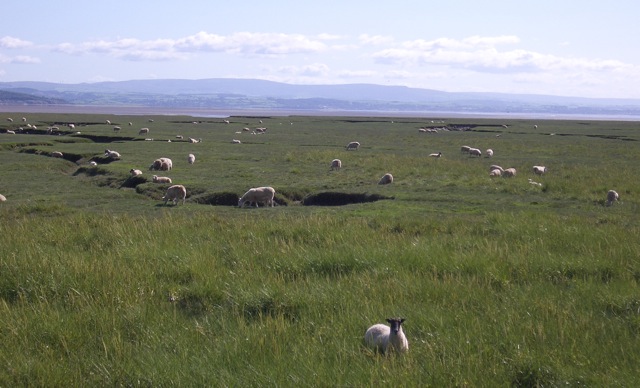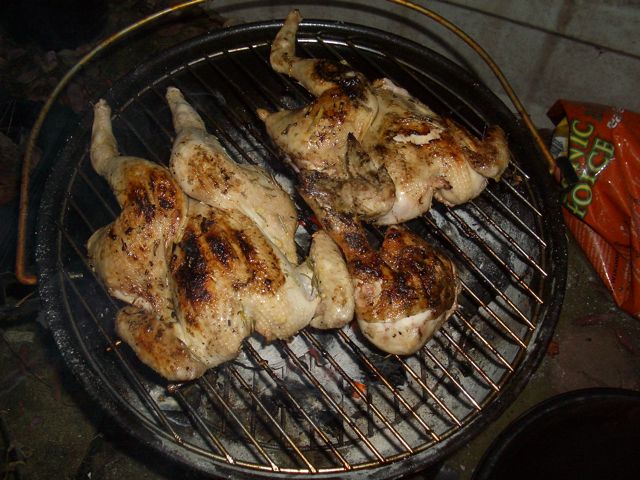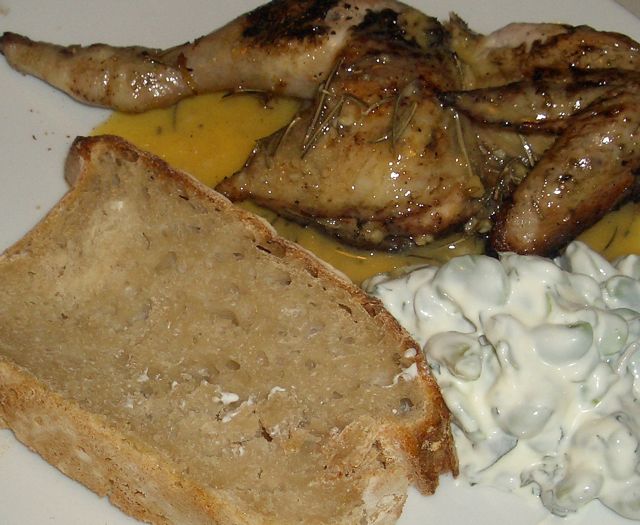I found some late English strawberries on offer in the supermarket a couple of weeks ago so I decided to make freezer jam with them
I’ve yet to taste the results but if it retains the taste the berries had it will be wonderful.
I found some late English strawberries on offer in the supermarket a couple of weeks ago so I decided to make freezer jam with them
I’ve yet to taste the results but if it retains the taste the berries had it will be wonderful.
“Ahhhhh…” came the voice from beyond the fence, “it isn’t a proper British summer without crab sandwiches, it really isn’t….I do declare that crab sandwiches are the epitome of the British seaside”. We sniggered quietly, picturing the lady next door lying on her sun lounger eating crab sandwiches and extolling their virtues loudly to no one in particular.
And although amusing she had a point, proper sandwiches made with good brown bread, some lemony mayonnaise and fresh fresh crab really are rather lovely, and very British. Of course there is nothing to beat the British coastline in August for variety and fun and food. From wide open huge sky sandy beaches, pebbly beaches, vertiginous cliffs, coves, rock pools, salt marshes to faded Victorian promenades, piers, arcades, fish and chips, greasy spoon cafes, beach chalets, fresh fish, and cockles; there is something for everyone whether its a day trip or a proper holiday. Best of all though, lots of the smaller seaside towns seem to have wonderful food on offer, you don’t have to go to Padstow these days, all along the coast you can find great food.
Regardless of whether you are at the seaside you can bring something of the salty freshness of British seaside air to you table with two of the best coastal produce that are in season right now…yes those brown crabs and samphire. As ever the fresher the better, if you are happy to cook crab yourself then buy live and follow the RSPCA advice on humanely dealing with the crab before cooking in salted water for 12 mins for the first 500g and 5 mins for every extra 500g. Pick out the meat and use in a simple salad or sandwich, with good brown bread of course, I use this recipe from my blog but with 50-70% wholemeal flour, the rest white flour and all water for the liquid (though part milk will work well too).
There are lots of fancy recipes for crab but I find because the meat is very rich simpler is better and preferably with something to counterpoint the richness. Things that work well are green vegetables such as broad beans or peas and curiously eggs and perhaps a little chilli. And of course samphire, the saltiness cutting through the richness perfectly.
Samphire has been having quite a renaissance in British cooking and is now rather sought after. It can be hard to find as it usually sells out quickly but persevere and you will be rewarded with something that can be eaten simply steamed and dressed with butter a bit like asparagus, on salads, or as a side vegetable particularly with fish or lamb. You can try foraging for some if you are near an estuary (flat wide muddy ones are best, but be certain you know what you are collecting, don’t pull up the roots, don’t over collect and be sure you have permission to collect it). It keeps reasonably well with the ends wrapped in damp newspaper. When you are ready to eat it trim off the thicker ends, depending on how you are going to use it you may want only the top few inches of the tips as the thicker parts have an inner stem. Its easy to suck the juicy flesh off the stem when you are eating it as a side dish but in a tart or omelette or other dishes its better to have only the tender tips. I usually steam it for around 5 minutes (don’t add any salt), any longer and its less flavoursome. If you happen upon an abundance then you can freeze it (blanch for 2 minutes first) or pickle it, though in my kitchen it doesn’t last long enough for either of those two things to happen.
But what of combining crab and samphire into a perfect seaside influenced dish. Two wonderful possibilities spring to mind: a tart and a pasta dish. I found this tart recipe blogged recently by Ailbhe of Simply Splendiferous so rather than create my own version take a look at hers. And for those of you who fancy a pasta dish try this:
Crab and samphire pasta (4 people)
75g dried linguine or spaghetti per person
1 medium brown crab
75-100g samphire (if you can’t get samphire then spinach or green beans would work well)
1 fresh chilli chopped finely or a pinch of chilli flakes
Method:
This article was first posted in Francoise Murat’s newsletter.
At last the English fruit season has arrived. The gooseberries and strawberries are in full flow and the raspberries, cherries and currants (black, red and white) are all just starting to come into their prime. For all these fruits when the season starts and end is inevitably affected by the weather and where you are in the country, some have much longer natural seasons than others and making the best of each while you can is what its all about.
I like them fresh of course, or cooked in compotes, sauces and pies and some preserved to bring a little summer light into the autumn and winter. All these fruits are native to Britain in some form although the varieties we eat now hail from the experiments of plants-men across Europe and America. Cherries were being cultivated in Britain during the middle ages, gooseberries in the 15th century, black (and other) currants and raspberries in the 1600s. It seems that strawberries are very much the latecomers to the party only really becoming widely grown from the 19th century onwards.
I just can’t resist pinching a few cherries from the bowl each time I pass so they never last long enough to be made into anything, perhaps if I had a cherry tree I might manage to save a few for other things. This year I’m going to see if I can find enough (and not eat them all first) to try pickling some as I think they would be wonderful with a cooked ham in the depths of winter. And red, black or white currants are a tasty counterpoint to other fruits especially in summer pudding.
But truth be told its raspberries I love the most.
Fortunately the different varieties mean the season lasts from late June to Autumn. I have a theory that you are either a raspberry or a strawberry person at heart. Given a choice of both most people I know always plump for the same one, few dither, unsure as to which to have this time. Its not quite on the scale of a marmite love-hate thing but its there, strawberries OR raspberries is the way it seems to go. In Simply British Sybil Kapoor suggests raspberries are regarded with deep affection not adulation; I think she might be right.
Me, I’m a raspberry person through and through. The fresh fruit is better, the jam is better, better in tarts, just better. Faced with delicious, plump, wonderfully fragranced version of each raspberries always win and I’m happy to say no to strawberries even if there is no alternative. Their sweetness seems too saccharine, their texture odd; I like the slight tart edge and depth of flavour that even the sweetest raspberry has.
Although I’m not alone in this love of raspberries the majority seem to prefer strawberries seeing them as the perfect example of a British summer. The Johnny come lately to the table seems to have usurped the more historic fruit, with Bunyard musing in The Anatomy of Dessert why raspberries and cream are so much less popular than strawberries and cream. I suspect it’s that tart edge. He suggests a drop of champagne makes the raspberries more delicious. It might also be the connection raspberries have with use in tonics for the stomach and other ailments, but the old vinegar recipes I’ve found sound really refreshing as a drink and no comparison to the raspberry vinegar madness of nouvelle cuisine. And apparently made with malt vinegar it’s used to dress Yorkshire puddings!
Raspberry Vinegar
I love the wording of this early 1920’s recipe from Kitchen Essays by Agnes Jekyll:
“Take 1 lb. raspberries to every pint of best white vinegar. Let it stand for a fortnight in a covered jar in a cool larder. Then strain without pressure, and to every pint put ¾ lb. white sugar. Boil 10 minutes, let cool, and bottle in nice-shaped medium-sized bottles saved perhaps from some present of foreign liqueurs or scent. A teaspoonful stirred into a tumbler of water with a lump of ice, or introduced to a very cold siphon, will taste like the elixir of life on a hot day, and will be as pretty as it is pleasant.”
In my case I suspect its memory that holds the key to my love of raspberries….a walk, some French cricket then picking raspberries from my grandad’s raspberry patch and having then at tea with thick golden Jersey cream. It sounds all rather grand and Merchant Ivory but it wasn’t, it was suburban Liverpool in the 1980s, you can grow great raspberries plenty of places if you try. I’m sure we only ever had the raspberries with thick cream, simple and delicious, maybe occasionally my grandad made a flan with them, one of those classic sponge flan bases you could buy and probably a teeny bit of jelly to hold the whole thing together, but there was still always served with Jersey cream. It sounds so retro now, raspberry flan, I’m sure its time for a reinvention…..I’m hoping to perfect one for the blog soon but initial trials are hampered by the raspberries constantly going missing….someone here clearly has a deep affection for them!
This blog post was first published in Francoise Murat & Associates July Newsletter.
It’s late spring (well it was when I wrote and it was published, we’ve now just edged into summer) and a time many of us associate with lamb, in fact, it’s common to think of lamb as a traditional dish for Easter. A moment to pause and think about this should make us wonder why? Easter can be as early as 22 March and as late as 25 April; and we mostly all know that spring is when lambs are born so how are these lambs old enough to be ready to eat by Easter? Well they aren’t. The lamb that is marketed early was born in autumn and there are some breeds where this is the norm (primarily Dorset breeds such as Down, Horn or Poll). But not that many so unless you are sure of your source you might be paying a premium price for lamb that has been ‘encouraged’ to lamb in the autumn and then had an indoor life fed on concentrated feeds such as soya pellets. Not perhaps as natural as you might hope. Like almost anything in food it pays to know the provenance of what you are buying including when things are truly in season and what might have been involved to bring them to you essentially ‘out of season’. So the majority of British lamb is not yet ready for the table but will start to be when we get near the end of June and into July, at its best by September when it will really pays to explore different breeds that have been grazing outdoors on their local flora for a good 5-6 months; then you’ll be able to taste the effects of grazing on salt marshes or moorland, highland or lowland.

But what to do until then, after all it feels like it should be time to have some lamby dishes whether British inspired or from further a field. Well you can seek out some lamb from breeds that do naturally lamb in the autumn, as the meat will be top notch right now. You could simply wait and bide your time. You could buy New Zealand lamb; no don’t do that! Although excellent from good producers on its home soil it’s almost impossible to know in the UK whether you are buying good, indifferent or poor quality. Or you could try British reared hogget or mutton instead. Technically a hogget is a sheep between 1 and 3 and mutton is 3+ years old.
Ah mutton yes. I know I’ve immediately conjured pictures of old good-for-nothing stringy over cooked meat, Mrs Beeton and over boiled vegetables! Of course this is not the case mutton is as delicious as lamb, just different. As Hugh Fearley-Whittingstall points out (in his seminal The River Cottage Meat Book, highly recommended for all matters meaty) “mutton is to lamb, as beef is to veal”, both have a place but one is fuller in flavour the other more delicate. It seems that somewhere along the way we have lost this notion of mutton as delicious and now we even use lamb to make hot-pots, or ragouts. There has been a shifting in attitude since 2004 when Hugh first wrote his book with the likes of Farmer Sharp championing mutton with chefs and the public alike. But essentially mutton is still seen as the speciality and lamb the ‘regular’ option. This makes no real sense, many recipes that call for lamb use robust flavours that will simply drown the delicate flavour of even the best quality lamb, and the lack of sufficient fat means that lamb actually won’t respond well to some of the cooking methods. Best then to save the lamb for a special treat, cooked simply at its prime from July to September and instead invest in some mutton for your summer inspired dishes.
Good mutton doesn’t have to be cooked until its gray either (or indeed ever) a joint of hogget or ‘young’ mutton (3-4 years old) will work well roasted or barbecued but still left pink, it has a good balance of sweet fat to meat meaning it will be more succulent than pretty much any lamb would be right now. So for the next month (and most of the rest of the year) while we wait for lamb to really be in its prime why not try a cut of mutton?
Boned, butterflied leg or shoulder of mutton
½ – 1 leg or shoulder of mutton
½ bottle of red wine (right now its English wine week so you might want to track down an English red)
4 large sprigs of fresh rosemary
6 black peppercorns
1 – 2 tbsp oil (I use extra virgin rapeseed)
peel of an orange or lemon (only the outer surface not the pith, easiest done with a sharp potato peeler)
You can find out more about mutton and places to buy at www.muttonrenaissance.co.uk
This article was first published in Francoise Murat & Associates newsletter.
Last week I took part in Dan of Food Urchin’s dinner blogging challenge (called ‘Where’s my pork chop?’). Basically I cooked him some dinner and in return I got, well these:
I’m going to be blogging what I cooked for Dan in a separate post so check back for that in the next few days. Here I want to tell you some of what I’ve done with the veg so far.
Dan had been down to his allotment bright and early on the day of the swap and picked me a selection of goodies in their prime. In the bag were charlotte potatoes, curly kale, green (French) beans, courgettes and COURGETTE FLOWERS ?. I’d been hoping for some of the latter as I’ve only tried them once before and they aren’t that easy to buy. We’ve tried to grow our own courgettes this year but we aren’t having much success so far (the first lot of seeds didn’t germinate) so I was particularly delighted with the flowers.
Of course as everything had been picked only a few hours before I took the picture above the veg were absolutely bouncing with freshness. I was pretty pleased with my haul and it really demonstrated how lovely and fresh veg can be when their distance from the ground to the kitchen is short. I now have allotment envy.
So what I have I done with the veg so far?
Well as recommended by Dan I did some of the kale with oil and chilli. I actually steamed it first then gave it a quick sauté in rapeseed oil and chilli flakes. It was really good, the kale still had a little bit of crunch to it and the chilli complemented the slight bitterness that is inherent in brassicas like kale. I’ll definitely try it like this again and venture out into varying the spice choice as well.
Ahhhhhh its barbecue time of year and barbecue kind of weather: smell the grilling food, hear the chink of glasses, the laughter, the fun, the delicate aroma of firelighters, the burnt food, the lobster tinged neighbours. England, the summer.
 Here’s the easy chicken (well poussin actually) we did last night:
Here’s the easy chicken (well poussin actually) we did last night: We had homemade sourdough bread to mop up the sauce/juices and broad beans tossed in minty yoghurt.
We had homemade sourdough bread to mop up the sauce/juices and broad beans tossed in minty yoghurt.